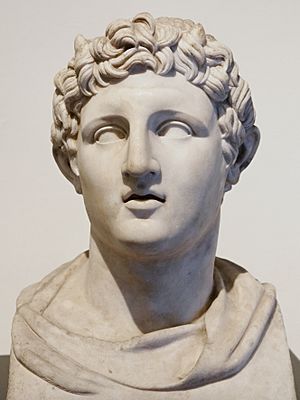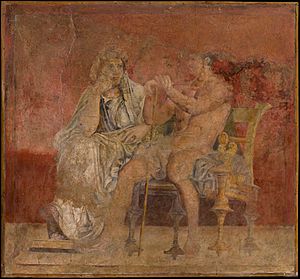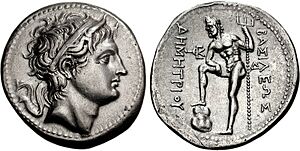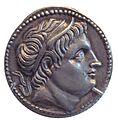Demetrius I Poliorcetes facts for kids
Quick facts for kids Demetrius I Poliorcetes |
|
|---|---|

Marble bust of Demetrius I Poliorcetes. Roman copy from 1st century AD of a Greek original from 3rd century BC.
|
|
| King of Macedonia | |
| Reign | 294–288 BC |
| Predecessor | Antipater I of Macedon |
| Successor | Lysimachus and Pyrrhus of Epirus |
| Hegemon of the Hellenic League | |
| Reign | 304 BC |
| Predecessor | Alexander the Great |
| Successor | Antigonus III Doson |
| Born | 337 BC |
| Died | 283 BC (aged 53–54) |
| Spouse |
|
| Issue |
|
| House | Antigonid dynasty |
| Father | Antigonus I Monophthalmus |
| Mother | Stratonice |
Demetrius I Poliorcetes (/dɪˈmiːtriəs pɒliɔːrˈsiːtiːz/; Greek: Δημήτριος Πολιορκητής, Dēmḗtrios Poliorkētḗs, lit. the Besieger of Cities; 337 – 283 BC) was a powerful Macedonian Greek leader. He was known for his military skills. He became king of Macedon from 294 to 288 BC.
Demetrius was part of the Antigonid dynasty. His father, Antigonus I Monophthalmus, started this royal family. Demetrius was the first of his family to rule Macedon in Hellenistic Greece.
In 307 BC, Demetrius freed Athens from its rulers. He then defeated Ptolemy I in a big sea battle called the Battle of Salamis in 306 BC. After this victory, his father was named "king." Demetrius earned his nickname Poliorcetes, meaning "the Besieger of Cities," after trying to capture Rhodes in 305 BC. Even though he didn't succeed, his use of huge siege engines was famous.
Later, Demetrius and his father lost a major battle called the Battle of Ipsus in 301 BC. His father was killed, and they lost much of their land. But Demetrius didn't give up. In 294 BC, he took control of Athens again. He then became king of Macedon. He ruled for six years until he was driven out by other powerful leaders. He died in 283 BC. His son, Antigonus II Gonatas, later made the Antigonid dynasty strong again in Macedon.
Demetrius was especially good at designing and using siege warfare tools and methods. He used massive siege engines and planned large-scale sieges. He also used amphibious warfare, attacking from both land and sea. He was known for how quickly he carried out his sieges. Demetrius also used his skills to build strong defenses for cities like Athens and Corinth.
Contents
Demetrius's Life Story
Early Adventures
Demetrius started his military career fighting alongside his father, Antigonus I Monophthalmus. This was during the Second War of the Diadochi, a series of wars fought by Alexander the Great's generals.
He led the cavalry in the Battle of Paraitakene. Even though parts of his army struggled, Demetrius's success on his side helped prevent a total loss. He was also present at the important Battle of Gabiene.
When he was 21, his father left him to defend Syria. He lost the Battle of Gaza to Ptolemy. But he soon won a smaller victory against one of Ptolemy's generals. In 310 BC, he tried to take Babylon from Seleucus I Nicator but was defeated. This loss meant his father's empire lost a lot of its eastern lands.
Becoming a "Saviour"
After fighting Ptolemy in other areas, Demetrius sailed to Athens with a large fleet. He successfully freed the city from the control of Cassander and Ptolemy. He removed their soldiers and captured the fortress of Munychia in 307 BC. Because of these victories, the Athenians honored him as their "Saviour" (Soter). Around this time, Demetrius married Eurydike, an Athenian noblewoman.
In 306 BC, Demetrius sailed to Cyprus. There, he won a huge naval battle against Ptolemy and his brother at Salamis. This victory greatly weakened Ptolemy's navy. After this, Demetrius conquered Cyprus. His father, Antigonus, then took the title of "king" and gave the same title to Demetrius.
The "Besieger of Cities"
In 305 BC, Demetrius tried to punish the people of Rhodes because they didn't support him. He became famous for inventing amazing new siege engines during this attack. One was a battering ram 180 feet (55 meters) long, needing 1,000 men to move it! He also built a huge wheeled siege tower called "Helepolis" (or "Taker of Cities"). It was 125 feet (38 meters) tall and 60 feet (18 meters) wide, weighing 360,000 pounds (163,000 kg). However, he failed to conquer Rhodes, and these giant weapons were left behind. The Rhodians even used the bronze from these abandoned weapons to build the famous Colossus of Rhodes statue.
In 304 BC, Demetrius returned to Greece. He brought back the Corinthian League, a group of Greek city-states. But his lavish lifestyle made the Athenians miss the previous government.
Major Battles and New Alliances
Demetrius's power made other leaders, like Seleucus, Cassander, and Lysimachus, worried. They teamed up against him and his father. Their armies met at the Battle of Ipsus in 301 BC. This was a huge defeat for Demetrius. His father, Antigonus, was killed, and Demetrius lost many soldiers. He had to retreat.
After this loss, many cities turned against him, including Athens. But Demetrius soon made peace with Seleucus. He even gave his daughter, Stratonice of Syria, to Seleucus in marriage.
Athens was suffering under a harsh ruler named Lachares. Demetrius besieged the city for a long time. In 294 BC, he finally captured Athens. He showed great mercy to the people, even though they had turned against him earlier. This act of kindness was something Demetrius valued in a ruler.
After taking Athens, Demetrius changed the city's government. He appointed leaders who were loyal to him.
King of Macedonia

In 294 BC, Demetrius became king of Macedonia. He did this by killing Alexander V, who was the son of Cassander. He faced a rebellion from the people of Boeotia but secured the region after capturing Thebes in 291 BC. That year, he married Lanassa, who used to be married to Pyrrhus.
However, his rule in Macedonia was constantly threatened by Pyrrhus. Pyrrhus would attack Demetrius's kingdom when he was away. Eventually, Pyrrhus, Ptolemy, and Lysimachus teamed up against Demetrius. Many of his own people also turned against him. This forced Demetrius to leave Macedonia in 288 BC.
He tried to besiege Athens again but failed. He then went to Asia and fought against Lysimachus. His army suffered greatly from hunger and disease. He asked Seleucus for help. But fighting broke out between them. Demetrius's soldiers eventually left him on the battlefield, and he surrendered to Seleucus.
Demetrius's son, Antigonus II Gonatas, offered everything he owned to free his father. But it was no use. Demetrius died after being held captive for three years in 283 BC. His body was given to his son, and he was given a grand funeral in Corinth. Demetrius's family continued to rule Macedonia for many years, until the Romans conquered it in 168 BC.
Demetrius's Family
Demetrius had five wives:
- His first wife was Phila. They had two children: Stratonice of Syria and Antigonus II Gonatas.
- His second wife was Eurydice of Athens. They had a son named Corrhabus.
- His third wife was Deidamia, who was Pyrrhus of Epirus's sister. They had a son named Alexander.
- His fourth wife was Lanassa, who was Pyrrhus's former wife.
- His fifth wife was Ptolemais, daughter of Ptolemy I Soter. They had a son named Demetrius the Fair.
He also had a daughter named Phila with a woman named Lamia of Athens.
Demetrius's Impact
Military Genius
Master of Sieges and Logistics
 In Spanish: Demetrio I de Macedonia para niños Demetrius was an incredibly effective commander during sieges throughout his 30-year military career. He took the new ideas from Alexander and made them even bigger and better.
In Spanish: Demetrio I de Macedonia para niños Demetrius was an incredibly effective commander during sieges throughout his 30-year military career. He took the new ideas from Alexander and made them even bigger and better.
He not only used huge siege engines often, but he also became an excellent logistician. This means he was great at planning and supplying his armies. He could keep very large sieges going for a long time, which was new for that era. Demetrius also used amphibious siege warfare, attacking cities from both the sea and land.
Even though some of his sieges failed, like the one at Rhodes, he was known for how fast he attacked. He would capture cities one after another in just a few months. For example, in 304-303 BC, he quickly took many cities like Epidaurus, Sicyon, and Corinth. Some ancient writers even claimed Demetrius commanded 110,000 soldiers at one point. While this number might be too high, it shows he could gather huge armies, some of the biggest of his time.
Military Engineer and Builder
Demetrius was also an important military engineer and builder of fortifications. He created new strategies and developed new siege engines for specific challenges. He also built and improved many city defenses, leaving a lasting mark on Greek history.
For example, after he first captured Athens in 307-306 BC, he started one of the biggest fortification projects in the city's history. In 303 BC, after taking Sicyon, he noticed its weak defenses. He decided to move the entire city to a better, more defensible spot. It's said he even helped build the new city himself.
Corinth also received major new defenses from Demetrius after he conquered it. These examples show that Demetrius was not just a warrior but also a skilled builder king.
See also
- Winged Victory of Samothrace
- List of sieges conducted by Demetrius I Poliorcetes
- Campaign of the Chersonese
Images for kids






